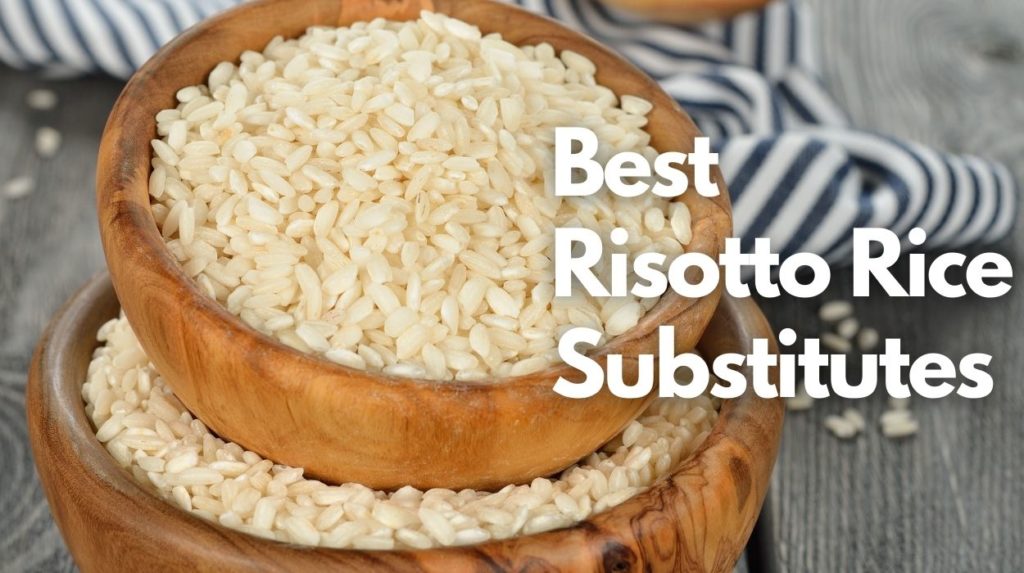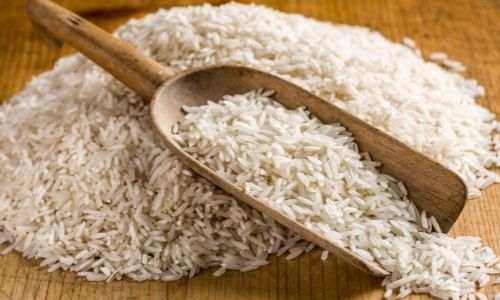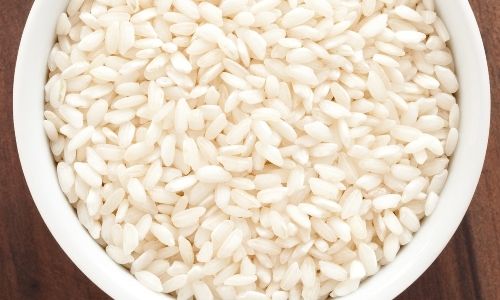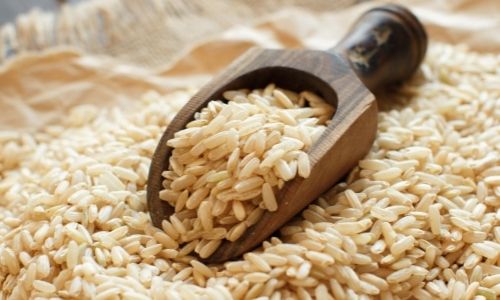
Risotto is one of the best options for people who want to try a richer version of mac and cheese. It is a creamy Italian dish that works as comfort food for people, including us.
It is generally made from arborio rice, making the risotto soft and mushy. But if you cannot seem to find arborio rice, you can substitute it with other alternatives like Basmati rice, Pearled Barley, Carnaroli rice, etc.
However, before we get to the substitutes, it is necessary to understand the characteristics of arborio rice. This will help you pick out its perfect replacement.
What is Arborio Rice OR Risotto Rice?
Arborio rice is native to Itlay. It is also named after a small town in Po Valley called Arborio, situated in Italy.
It is a short-grain rice that contains a high amylopectin starch content. On cooking, these rice remain firm yet creamy and chewy, making them the preferred choice for risottos and rice pudding.
Due to its rich texture and high starch content, arborio rice retains most flavors and makes the dish even more enjoyable and delicious.
How is Arborio Rice used?
Arborio rice is often used to make risotto, but its usage isn’t limited to that. It can be used to prepare recipes that require plump and creamy rice.
For example, Paella requires short and plump rice that soaks up the chicken juices and spices up the dish. Arborio rice does precisely that! Secondly, you can add it to rice pudding.
Since cooked Arborio rice gets creamy while retaining its shape, it can be used to prepare Arancini. Lastly, Minestrone gets enhanced with Arborio rice as it soaks the broth and thickens it.
Nutrition Facts of Arborio Rice
Even though Arborio rice has a high nutritional content, it doesn’t necessarily mean it has a high amount of starch.
Generally, a 1/4th cup of uncooked Arborio rice provides 38 grams of carbs, 0.5 grams of fat, and 4 grams of protein.
Since it contains a significant amount of fiber, at least as compared to normal-grained rice, it helps in hunger control, obesity, and reducing the risk of heart diseases. This can make it easier for people to enjoy the rice while maintaining their weight and diet.
As far as calories are concerned, Arborio rice has the same amount of calories as that of normal rice, approximately 170 calories per 1/4th cup.
Lastly, while this rice might not have any vitamins or minerals, it contains iron. You can prepare the rice with any meat to enhance iron absorption.
What Is Arborio Rice Good For?
The following are some of the health benefits of Arborio rice:
- Stimulates the production of hormones and enzymes
- Regulates the digestive process
- Provides energy to the body
- Aids weight loss
What Can I Substitute for Arborio Rice?
Now that we have a basic idea about risotto rice let us look at its best substitutes.
1. Basmati Rice

Wait, basmati rice for risotto?
That was our first question as well during our research. However, the more we dwelled on it, the more we realized the taste and consistency of basmati rice.
Basmati rice is a long and aromatic rice variety that is native to India, Nepal, and Pakistan. But you can easily find it in any supermarket.
Since basmati rice is gluten-free, you might not get your desired consistency for risotto. However, adding pumpkin broth can make it seem sticky and chewy. If you do not have pumpkin broth, try letting the rice sit in water before and after steaming. This will give it a sticky consistency.
Another reason to substitute arborio or risotto rice with basmati rice is the health factor. Both have the same medium glycemic index (69), making them a reliable option for people with diabetes.
2. Sushi Rice
Contrary to the name, sushi rice is not just used to make sushi. This short-grain rice originates from Japan and is added to several dishes, in addition to sushi, to benefit from its creaminess.
It has a higher starch content, making it a dependable choice for risotto. Furthermore, it is fat-free, making it a low-calorie option for people trying to maintain their weight. However, it has a higher glycemic index. So it is best to avoid it for people with blood sugar issues.
You can use it to make risotto, but try not to overcook it since it might lose its texture and flavor.
3. Carnaroli Rice

Carnaroli rice comes from the same land as Arborio rice- Italy. It is one of the best options for risotto due to its high starch content and texture.
This long-grain rice gives a better texture to the risotto or any other dish. Moreover, it has a high amylose content that makes it highly suitable for Italian cuisines.
While you can expect softer risotto with arborio rice, you can prepare a creamier one with carnaroli rice. Since it is whitened with helix, you get intact grains. Moreover, with its low glycemic index, you can maintain your health without compromising on your taste.
No wonder this rice is referred to as “the king of rice.”
4. Brown Rice

Brown rice has a nutty taste with a chewy texture, making it a reliable option for preparing risottos.
Compared to white rice, brown rice has a grainier and thicker texture, which can help your risotto stand out.
This whole-grain rice has its outer hull removed, thereby elongating its cooking time. But that shouldn’t pose a problem since risotto is a slow-cooked dish.
It is rich in flavonoids and phenols that prevent signs of premature aging. Moreover, it is rich in vitamins and minerals, making it a healthier option.
It has 50 GI, falling in the lane of arborio rice.
5. Couscous
You can use Israeli couscous instead of risotto rice to make a creamy, rich, and sticky dish.
Even though couscous is a form of pasta instead of a seed or grain, you can use it to make a chewy and creamy risotto since it is a starch.
You can prepare Israeli couscous in several ways to make risotto. For example, boiling it can make the rice softer and chewier.
If you want to retain the texture, you can also toast the grains and add them to the broth.
Couscous has a GI rating of 65, similar to that of arborio rice.
6. Jasmine Rice
Another long-grain option- Jasmine rice, comes from Southeast Asia. It has a sticky texture with a certain level of fluffiness after cooking. This makes it a good option for risotto.
You can find varying colors of jasmine rice like brown, red, white, purple, and black. Moreover, it has a popcorn-like smell that can make your risotto gourmet-level.
If you think that jasmine rice will not bring the right amount of creaminess, you can add broth to make it sticky and rich.
But we wouldn’t recommend this alternative to people with diabetes due to its high glycemic index (109).
7. Red Cargo Rice
Red cargo rice or Thai red rice is long-grain rice that is free from gluten. It is similar to brown rice in terms of texture and nutrition.
It is rich in vitamins, fiber, calcium, and iron.
You can get a sweet and nutty flavor from red cargo rice. While it might take longer to cook, soaking them in water beforehand can shorten the waiting time.
Its glycemic index stands at 55.
8. Vialone Nano Rice
Vialone Nano Rice is short-grain rice. The “nano” word itself means dwarf in Italian. Nonetheless, you can use this rice to make creamy risotto as it retains the flavor and texture effectively.
It comes from the Mantua and Veneto regions of Italy.
Since this rice can absorb water twice its weight, you will get a rich and creamy risotto. You can also use it for soupy risotto.
It has a low glycemic index, making it a healthier option for everybody.
9. Calrose Rice
Calrose rice is a soft and chewy mderium0grain rice that is native to California.
After cooking, it has a mild flavor that can be incorporated with other spices and herbs to make delicious risottos as well as stews and soups.
Calrose rice is high in carbohydrates, but it is healthy enough to be used once in a while. It also has a high glycemic index, something that should be considered before substituting it with risotto rice.
9. Glutinous Rice
If you do not mind shelling some extra dollars for making risotto, we suggest using sticky rice.
While this rice is costlier than your regular white rice, it will certainly bring the required stickiness and chewiness to the table. This is due to their high starch content.
They have short-grain as well as long-grain varieties.
Apart from risotto, you can also use sticky rice to prepare dumplings. Due to their sweet taste, you can use them to prepare porridges and puddings as well.
It has a glycemic index of 86.
Top 5 Wheat And Pasta That Can Substitutes Arborio Rice
The following are our handpicked options for using wheat and pasta instead of Arborio rice:
1. Bulgur Wheat
Bulgur wheat is a whole grain that originates from the Middle Eastern and Mediterranean regions. You will find it prominently being used in West Asian cuisines, mainly in making kheer pudding, tabbouleh, kibbeh meat patties, etc.
It has a mild nutty and earthy flavor with a chewy consistency, making it suitable for making risotto. Moreover, it is quite easier to prepare.
Bulgur wheat is not to be confused with cracked wheat. The former one is dried before being grounded, while the latter one isn’t.
It is rich in several nutrients like fiber, protein, vitamins, minerals, etc.
Apart from making a risotto, you can use it to replace ground meat in chili and tacos. It also blends well in stews, soups, and porridges.
It has a low glycemic index of 47.
2. Couscous
You can use Israeli couscous instead of risotto rice to make a creamy, rich, and sticky dish.
Even though couscous is a form of pasta instead of a seed or grain, you can use it to make a chewy and creamy risotto since it is a starch.
You can prepare Israeli couscous in several ways to make risotto. For example, boiling it can make the rice softer and chewier.
If you want to retain the texture, you can also toast the grains and add them to the broth.
Couscous has a GI rating of 65, similar to that of arborio rice.
3. Farro Wheat
Farro grains will remind you of brown rice due to their nutty taste. Moreover, it has slight undertones of barley and oats that will make your risotto taste rich, creamy, and textured.
Farro is a grain of three wheat species- emmer, spelt, and einkorn. Out of the lot, you’ll be able to locate emmer in the USA.
As far as nutrition is concerned, it is rich in protein, fiber, and other vitamins. It has a GI of 45, making it a healthier option for people with diabetes.
4. Orzo Pasta
If you are able to crack the code of Orzo pasta, you can use this as a risotto rice substitute.
Even though Orzo is a form of pasta made from large-grain of rice, you can use it to prepare risottos.
It is rich in fiber and protein, making it a healthier and tastier option.
Since it is already being used in Italian soups, you can boil and fry it to make risotto.
Even though it has a low glycemic index, it must be consumed in moderation by people with diabetes.
5. Pearled Barley
Go for pearled barley to prevent yourself from going the extra mile in making your rice sticky. Since it has a high starch content, making it one of the best substitutes for risotto.
Not only does pearled barley get cooked in no time, but you also need not soak it beforehand. This is due to the removal of its fibrous outer hull. This saves you a lot of preparation time, which can be used to prepare for the other aspects of a risotto.
It excels in the health factor as well since it has a high vitamin, mineral, protein, and caloric content.
Apart from risotto, you can also use this rice to prepare soups, stews, stir-fries, salads, etc.
It has a low glycemic index of 22-29.
6. Quinoa
Quinoa has greatly impacted people’s minds after everybody started getting conscious about their health.
It is a grain that is cultivated in the Andes Mountains of South America by the Incan tribes. It is rich in all eight amino acids in addition to protein.
While it might not have any starch content, you can make a creamy risotto by adding milk or cream.
Since it is whole grain, it can be used to control blood sugar.
It has a glycemic index of 53.
A Comparison Chart For Arborio Rice Substitutes
If you want a quick summary, the following chart will help you make a quick decision.
| Name | Type of Substitute | Estimated Cooking Type (minutes) |
| Basmati Rice | Long-grain | 20 |
| Calrose Rice (Sushi Rice) | Medium-grain | 15 |
| Carnaroli Rice | Medium-grain | 15 |
| Vialone Nano Rice | Medium-grain | 12 |
| Brown Rice | Medium-grain | 40 |
| Glutinous Rice | Short and long-grain | 30 |
| Jasmine Rice | Long-grain | 12 |
| Red Cargo Rice | Long-grain | 45 |
| Bulgur Wheat | Wheat | 20 |
| Couscous | Pasta | 5 |
| Farro Wheat | Wheat | 20 |
| Orzo Pasta | Pasta | 20 |
| Pearled Barley | Grain | 30 |
| Quinoa | Pseudocereal | 25 |
Why is Risotto so Expensive?
At the basics, risotto is nothing but rice, broth, and aromatics. But the reason why it is more expensive in restaurants is due to the additional ingredients added to it. For example, risotto is often served with lobster, truffle, etc. This is why the price is always high.
The most expensive risotto in the world is the Saffron risotto made by Gualtiero Marchese. It contains 24 karat gold!
What Is The Best Arborio Rice Substitute For Rice Pudding?
As far as rice pudding is concerned, one can use risotto rice, carnaroli rice, arborio rice, and paella rice instead of arborio rice.
FAQs
Can I make risotto with regular rice?
If you are out of arborio rice, you can use your regular white rice by regulating the proportion. For example, use a lesser quantity for a runny risotto. On the other hand, add more broth if you want a soupier risotto.
If it doesn’t turn out to be creamy, you can try adding extra milk or cream.
Does risotto taste like rice?
Risotto is an Italian dish that is made from rice. It has a heavy, sticky, creamy, and rich consistency. It is made by adding other vegetables, herbs, and spices.
What Is The Best Arborio Rice Substitution For Paella?
Short or medium-grain rice like Calrose is the best Arborio rice substitute for paella. While it might not retain the original authenticity, it can still work to provide a similar consistency and texture.
Can I make risotto with medium grain rice?
Since medium-grain rice has the right amount of starch content, it can be used to make risotto. It will help one get the necessary consistency and texture while enhancing the taste of the broth.
Final Note
Not only does risotto work as a heartwarming dish, but it also requires minimum ingredients and time. Even if you are out of the required rice, other options like basmati rice, pearled barley, brown rice, or sushi rice certainly do justice to its creaminess.
Which substitute will you be going for? Let us know in the comments below!



